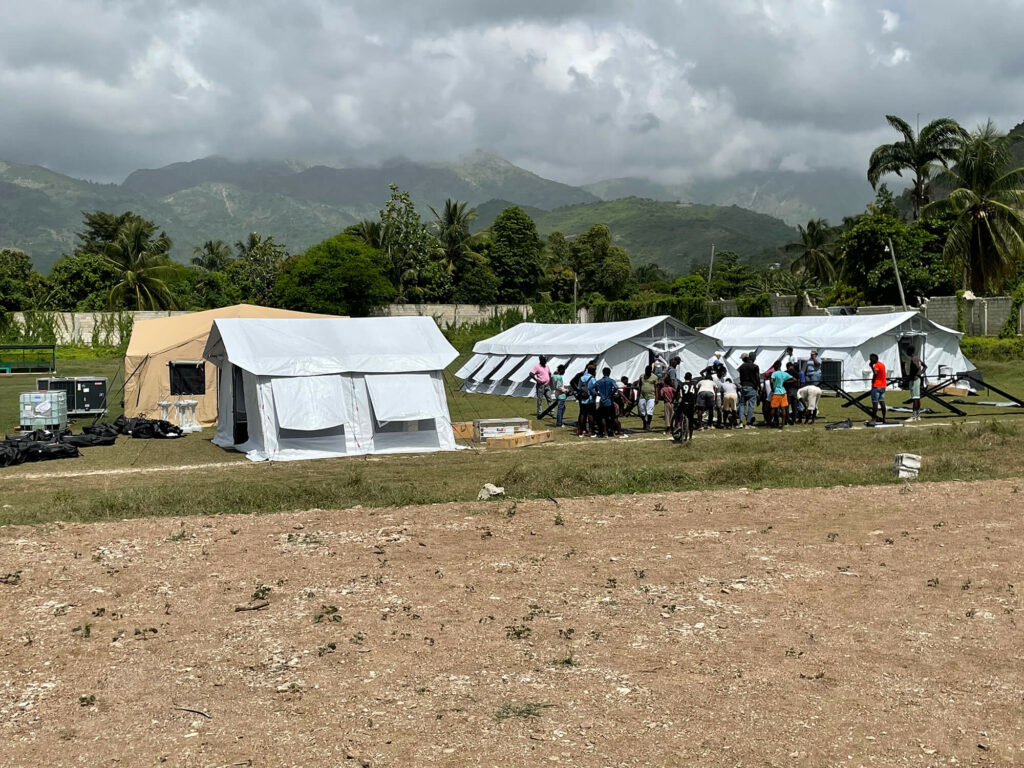Haiti, the poorest country in the Western Hemisphere, has been marked by injustice and catastrophe for decades. Recently, the tiny island nation once again dominated headlines with the shocking assassination of its president on July 7, followed by a 7.2 magnitude earthquake that struck on August 14, leaving around 650,000 people in urgent need of humanitarian assistance. By most accounts, the story of Haiti is considered a tragedy. But to the International Medical Corps team members who have been working there, Haiti remains relentlessly resilient—and hope prevails.
Many of our team members vividly remember the last major disaster in Haiti: the catastrophic 2010 earthquake that virtually flattened the crowded capital of Port-au-Prince, killing at least 200,000 people. International Medical Corps was on the ground within 24 hours and launched a massive emergency response that reached tens of thousands of people over seven years. Hundreds of other NGOs also poured into the country or sent assistance, each using wildly different approaches that often lacked coordination.
“This meant that a lot of the response from the international community ended up being extremely inappropriate,” says John Roberts, International Medical Corps’ Emergency Response Lead in the US. “For example, people sending winter coats to this hot and humid island, or medical teams trying to do surgery in the streets.”
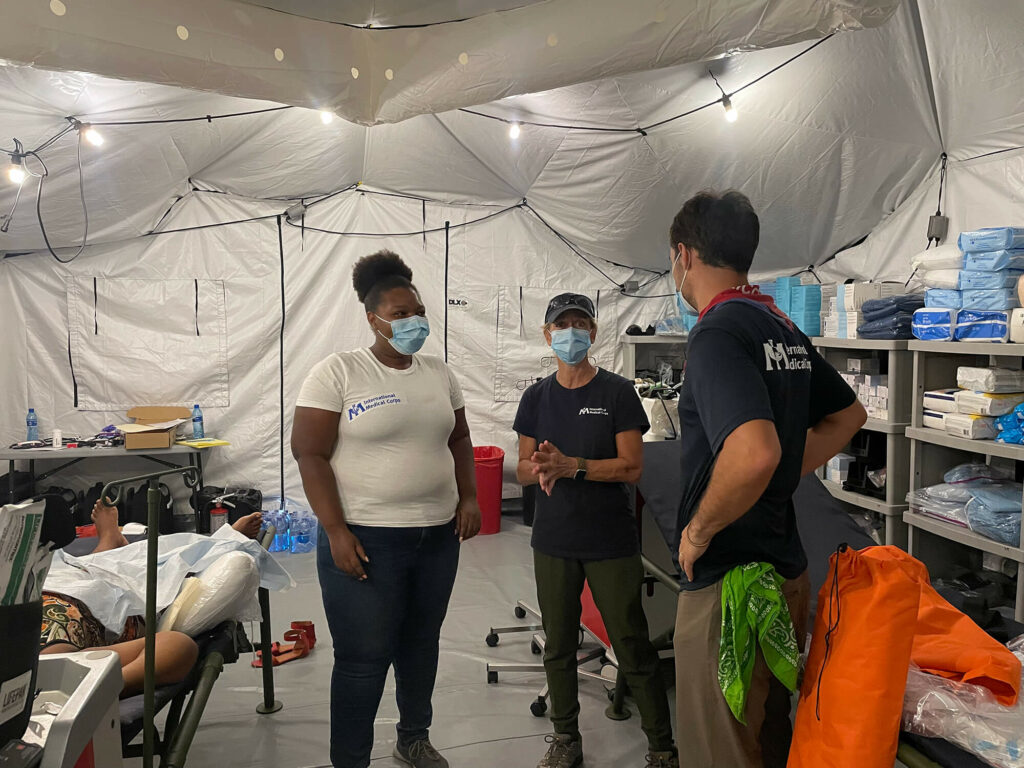
In the wake of this chaos, the World Health Organization (WHO) recognized an urgent need for standardizing care, and started the process of creating an Emergency Medical Team (EMT) model to ensure a consistent high standard of care, accountability and measurability in humanitarian disasters. This past June, 11 years after the 2010 Haiti earthquake, International Medical Corps became the first American NGO to be classified by the WHO as a Fixed Type 1 EMT provider, capable of deploying a field outpatient facility quickly and providing medical services in response to a disaster anywhere in the world.
“We’ve been an effective emergency medical agency for decades, but the EMT is a gamechanger,” says Roberts. “It increases our capacity, giving us the ability to see at least 100 patients a day in a clinically effective manner on par with the kind of care we could deliver in the US.”
Coming Full Circle
A few weeks after classification by the WHO, International Medical Corps deployed our EMT to the field for the first time with the help of our longtime supporter, FedEx—sending it to Haiti, where it all began. “For someone who worked on the EMT project from the start, it was truly an impressive sight to see it be deployed in Haiti,” says Susan Mangicaro, International Medical Corps’ Emergency Response Team Lead. Within a matter of several days, the EMT—which takes up roughly the space of a football field—was up and running with clean water, air conditioning and internet access. It operates with two consultation tents, a fully stocked pharmacy with a pharmacist and assistant, a reproductive health center, an infectious outbreak/isolation tent and more.
Upon returning to the US from two weeks of deploying the EMT and treating patients, Roberts showed photos of the EMT to a friend, who asked, “Why does it look so calm?” This, he says, is the biggest compliment she could have given. “I think it’s a testament to everybody who worked to develop these procedures and who put a lot of moving parts together seamlessly,” says Roberts. “This is the way that healthcare should be delivered in an emergency. We’re extremely proud of the way it started and how we have been able to continue it.”
But despite appearances, none of this was easy.
In contrast with the 2010 earthquake, which was concentrated in the capital of Port-au-Prince and therefore closer to shipping ports, the August 2021 earthquake affected Haiti’s entire southern peninsula. Just two days later, a ferocious tropical storm ripped through, wreaking further havoc. “The combination of it being an isolated location, with only a couple of ways in and out—mixed with gang presence and widespread damage to roads, airports and seaports—made it really, really hard to get supplies, equipment and personnel into the area,” says Roberts. “So even though it was the same country with a similar-sized earthquake, this time proved to be much more of a logistical challenge.”
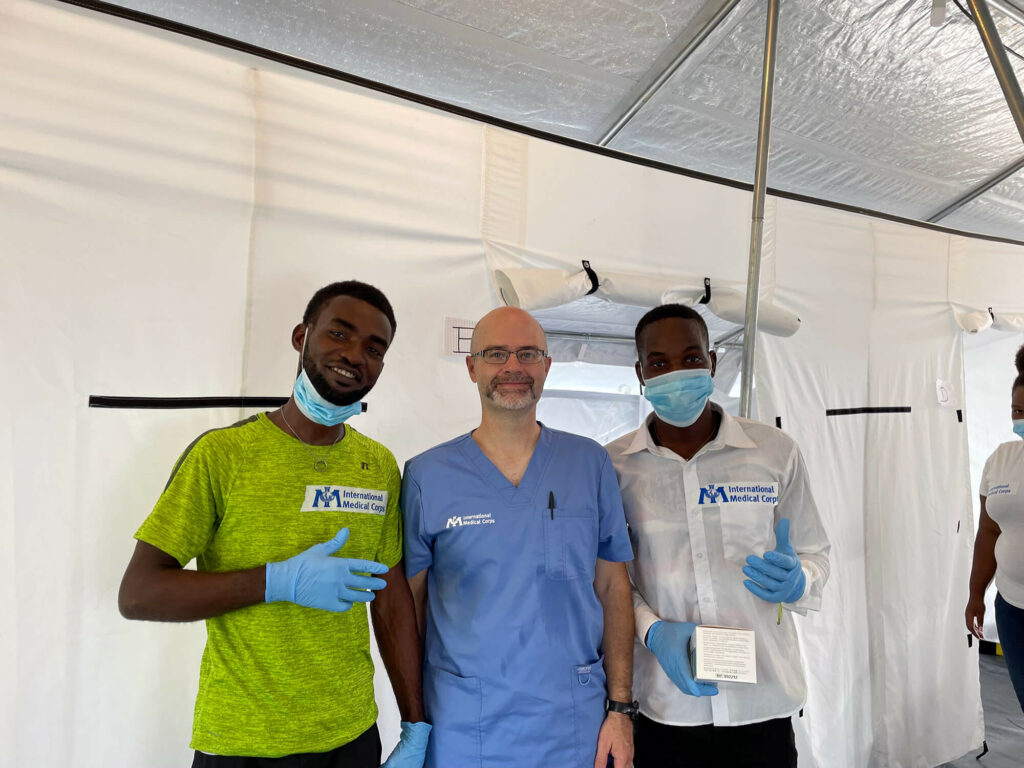
“It was a really intense set up—quite an undertaking,” says Chad Knaus, a medical doctor from Colorado who volunteered with us in Haiti. “Just tons and tons of gear, and lots of people going through hundreds of boxes and setting up very complex processes.” Adds Mangicaro: “Having been to Haiti multiple times and knowing how fragile the infrastructure is and how difficult of an environment it is, I think International Medical Corps did the best job of any NGO on the ground in terms of setting up in a timely manner—and I’m really proud to be a part of the organization.”
Getting Help Where It’s Needed Most
At the request of the Haitian government and the Pan-American Health Organization, International Medical Corps deployed the EMT to the hard-hit, southwestern town of Aquin. Says Knaus, “The place we’re working in really has been bypassed by both the Haitian government and other NGOs, so it’s an appropriate place for us to be. We can really make a big impact here.” Chronic poverty in the area, combined with an acute emergency and a lack of access to healthcare, means that needs have gone up exponentially. People’s homes—many of them multigenerational homes housing multiple families—have been destroyed, and people have had to sleep outside for weeks. Wells and other water sources have been destroyed, along with ways to purify water, get rid of waste, cook, stay clean and earn a living—the basics of survival.

In addition, the quake rendered the local hospital non-functional. With the next nearest health facility at least an hour away by vehicle, many of the residents went without healthcare—until International Medical Corps set up its facility. “When we got there, there was a strong feeling of despair and fear, and of just being overwhelmed,” says Roberts. “But we were able to come in and provide clinical services typically provided by the hospital, which was still trying to treat patients, but outside.” Within days, our team of medical volunteers were treating more than 100 patients a day, and had to turn away close to that number. The team adapted and scaled quickly to meet the overwhelming demand.
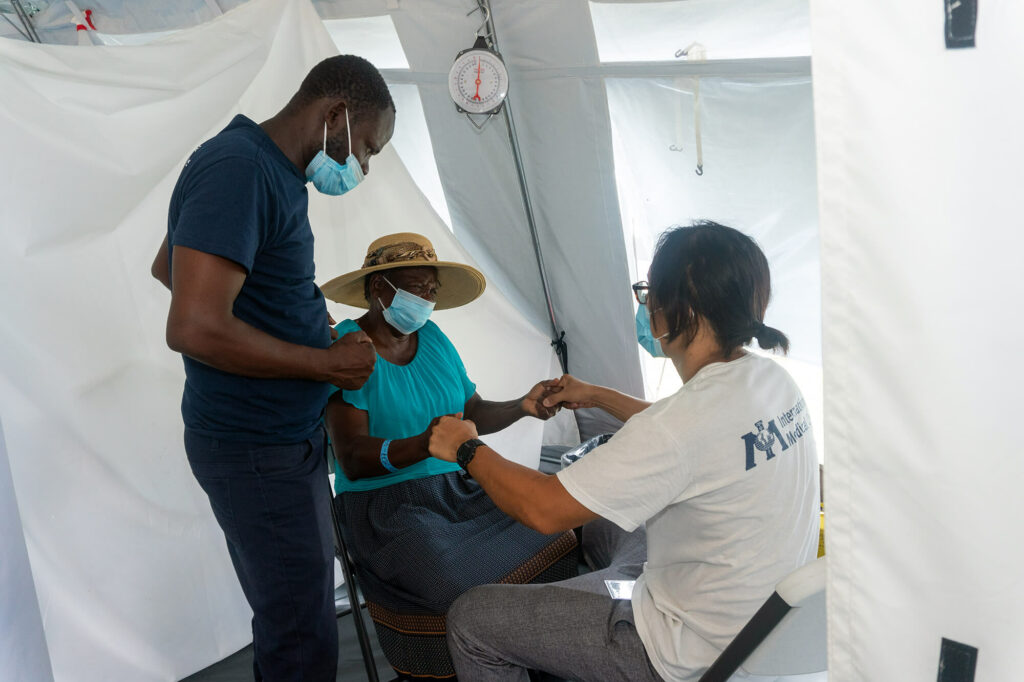
Many people have come into the clinic with fractures and impacts wounds from the earthquake, skin and respiratory infections caused by sleeping outside, and malnutrition and vitamin deficiencies because they’d lost access to nutritious or adequate food. “Everyone has diarrhea of some sort and stomach pain,” says Knaus. “We’re also seeing people who haven’t had any care in a long time and are just coming in to be checked on longstanding issues that have been worrying them.” In addition, through the EMT’s reproductive health center, our team has provided treatment for pregnant women and postnatal care for newborn babies—including saving the life of a two-week-old, severely malnourished infant, with help from two Haitian nurse trainees.
We’ve also been treating the “invisible wounds” caused by disasters like the quake. “In addition to providing all the things that you would traditionally think of as health needs, we have been seeing people coming in with acute psychosocial needs—people who were suffering from acute stress disorder, depression or just plain old grief, who haven’t been able to talk to anybody,” says Roberts. “And we found that there’s been a huge spike in cases of gender-based violence (GBV)—which, unfortunately, is fairly standard after disasters when people are stressed and displaced, and women and children are not protected.” International Medical Corps’ mental health and GBV specialists have launched long-term programs in the country to meet these needs.
Moving Forward
“I think we’re making tremendous impact, both through our initial post-earthquake emergency response and as we move on to the recovery phase,” says Mangicaro. “Our goal is to bring the care back to the local population.” True to our mission of training and strengthening local healthcare systems, International Medical Corps has hired Haitian staff in a wide range of clinical and support positions, and continues to build out the team.
“One of our greatest points of pride is that, when we deploy anywhere, we make efforts from the very beginning not only to deliver quality care but also to develop relationships with other organizations, as well as the government, to integrate our care into their responses and not be a parallel health system,” says Roberts. “We want to turn over the programming as quickly as possible, because there’s no substitute for having a local doctor or local nurse or local social worker helping their local community.”
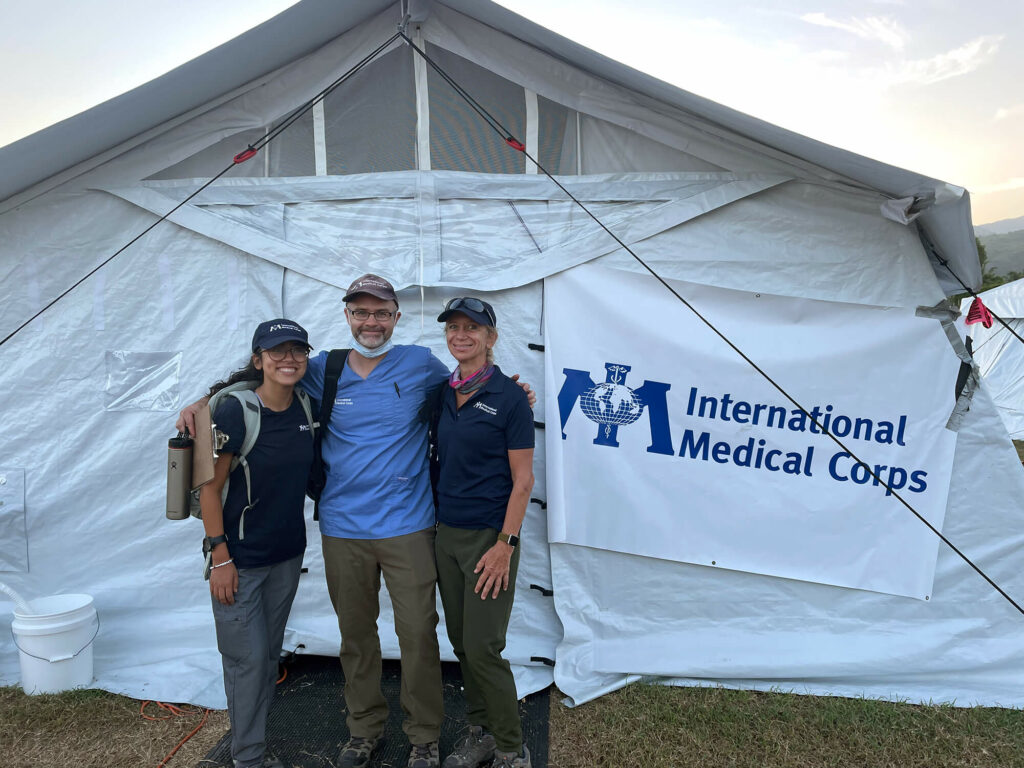
This emphasis on local ownership and resilience is what makes our difficult work worthwhile for staff and volunteers—along with the patience and gratitude they witness amid such calamity and despair. Mangicaro, who just finished her sixth deployment to Haiti, is often asked by friends and family—bewildered by the barrage of hopeless headlines about the country—why she keeps going back. She acknowledges that the environment is “really, really rough.” It’s a hot, humid, dangerous logistical challenge lacking nearly all human comforts. “But I think when you’re on the ground, and you’re working with a population and with each other to serve the greater good, and there’s just so much appreciation from everyone you meet for the work you’re doing, there is hope in the day-to-day activity and the relationships that are formed,” she says. “This work has purpose—and that’s what keeps us coming back.”
“It has been such a pleasure to be able to work with the people of Haiti and get to see them start to recover. I have really high hopes that we will see them come out of this disaster stronger than they’ve ever been,” adds Roberts. “I’m excited to see it—I really, really am.”
At the request of international aid agencies and the Haitian government, International Medical Corps began deploying its Fixed Type 1 EMT facility on August 31, and was treating patients by September 2. International Medical Corps was previously in Haiti from 2010–2017, arriving within 24 hours of the devastating 2010 earthquake and staying to help rebuild. To learn more about our Haiti emergency response and support our efforts, please visit: InternationalMedicalCorps.org/emergency-response/haiti-earthquake-2021.
